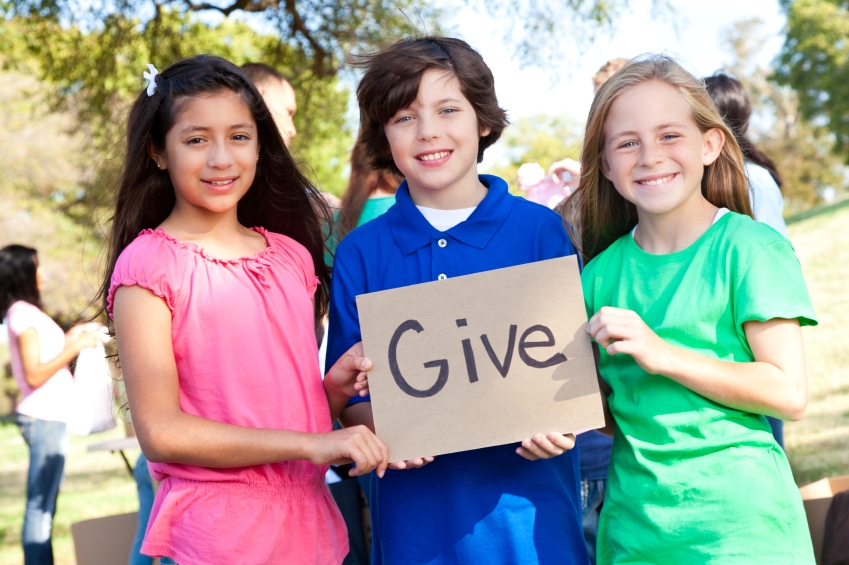
All of us have benefited, at least once, from someone’s generosity. Whether it was a gift for no reason from a friend, a ride to school or work, or a tip at your lemonade stand, gestures of kindness can change the world. As adults, we’re given hundreds of opportunities for giving each day. Think about it; you can round up your purchase at Evo (www.evo.com) to support local organizations, drop your coins in the containers at the window at McDonald’s as you drive through, you can respond to one of many emails asking for donations, and can buy chocolate from the neighbor kid to help their soccer team. But what about children? How can we teach them to help take care of the world through financial generosity when they don’t regularly shop, don’t receive emails, and might not (yet!) have the eye for knowing how and when to give? Well, we teach them.
Being a global citizen means caring about the world around you. It means understanding the ways you can make a difference and working hard to do it. It means giving because it’s necessary, not because it’s fun or will make you look good. Anyone of any age can give to others. Children can start as soon as they receive money for birthdays and Christmas. As they grow, include what they make at a lemonade stand, money they are paid for babysitting or doing yard work, and for older kids, their work paychecks. Consider talking to your child about always saving a percentage of what they receive to give to someone else. 10% is a great start. It’s enough for them to notice but leaves them to enjoy the rest. Craft a fun box out of an old oatmeal container, milk jug, or shoe box to keep the ‘give away’ money with a running tab of how much is in there with a goal of, say, $50 or $100. That anticipation of reaching a goal is always fun.
Talk to your child about the needs in your community. A simple Google search of “Nonprofits in _____” is a great way to start the conversation. Sit together and read about what you find. Use language they can understand to paraphrase each group’s mission. If your child is younger, think of or search for organizations that match their interests: a kitten rescue, a firefighter fund, nature conservation, or even skateboarding. Make them excited to give. Check out the list below if you’re stumped. Happy giving!
Animals
House of Dreams (www.kittydreams.org) – no-kill, free-roam cat shelter
Animal Law Coalition (www.animallawcoalition.com) – advocates for animals to live free of cruelty and neglect
Oregon Animal Rescue – rescues abandoned and older neglected horses
Environmental
Freshwater Trust (www.thefreshwatertrust.com) – preserves and restores freshwater ecosystems
Next Step Recycling (www.nextsteprecycling.org) – educates public about the importance of recycling
Oregon Wild (https://oregonwild.org) – works to protect and restore Oregon’s wildlands, wildlife, and waters
Sports
Skate Like a Girl (www.skatelikeagirl.com) – creates an inclusive community through skateboarding
Sport Oregon (www.sportoregon.org) – supports youth sports activities focusing on underserved youth
Oregon Adaptive Sports (www.oregonadaptivesports.org) – supports outdoor sports participation for all abilities
People
Spirited Justice (Venmo: spiritedjustice) – redistributes wealth throughout the Black and Brown communities.
Q Center (www.pdxqcenter.org) – provides a safe space for members of the LGBTQIA+ community
Project 48 (www.project48.co) – provides essential items for youth experiencing foster care

Ruthie Prasil is a mom to six children living in the Portland area, born and raised in the PNW. When she’s not making snacks, doing laundry or cleaning the kitchen, Ruthie loves going to the beach, reading, watching The Real Housewives and anything scary, and eating delicious food with an incredible cocktail. If you love stories about terrible school pickup lines, uninteresting school lunches, and so many mommy fails, follow her on IG at @ruthiep1985.
One thought on “Teaching Kids About The Importance Of Giving – Why It’s Important, Who Can Give, And Oregon Organizations To Donate To”
Comments are closed.

Great thoughts- so important to instill the importance of supporting others! Especially if we’re lucky enough to have multiple privileges.